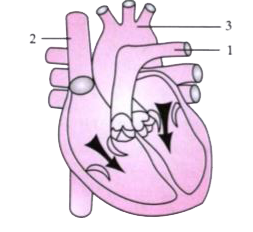Distinguish between pollination and fertilisation. Mention the site and product, of fertilisation in a flower. Draw a neat, labelled diagram of a pistil showing pollen tube growth and its entry into the ovule.
Step-by-Step Solution:
1. Definition of Pollination:
- Pollination is the process by which pollen grains from the anther (the male part of the flower) are transferred to the stigma (the receptive part of the female organ) of the pistil. This can occur through various agents such as wind, water, or animals.
2. Definition of Fertilization:
- Fertilization is the biological process that occurs after pollination, where the male gamete (from the pollen) fuses with the female gamete (inside the ovule) to form a zygote. This is a crucial step for the development of seeds and embryos.
3. Distinguishing Features:
- Pollination:
- Type: Physical process
- Purpose: Transfer of pollen grains to the stigma
- Outcome: Pollen grains are positioned for fertilization
- Fertilization:
- Type: Biological process
- Purpose: Fusion of male and female gametes
- Outcome: Formation of a zygote
4. Site of Fertilization:
- Fertilization occurs inside the ovule, which is located within the ovary of the pistil.
5. Product of Fertilization:
- The product of fertilization is a diploid zygote, which will eventually develop into an embryo and later into a seed.
6. Diagram of a Pistil:
- Draw a labeled diagram of a pistil showing:
- Stigma (the top part)
- Style (the elongated tube)
- Ovary (the swollen base containing ovules)
- Pollen tube growth from the stigma through the style to the ovule.
- Pollination is the process by which pollen grains from the anther (the male part of the flower) are transferred to the stigma (the receptive part of the female organ) of the pistil. This can occur through various agents such as wind, water, or animals.
- Fertilization is the biological process that occurs after pollination, where the male gamete (from the pollen) fuses with the female gamete (inside the ovule) to form a zygote. This is a crucial step for the development of seeds and embryos.
- Pollination:
- Type: Physical process
- Purpose: Transfer of pollen grains to the stigma
- Outcome: Pollen grains are positioned for fertilization
- Fertilization:
- Type: Biological process
- Purpose: Fusion of male and female gametes
- Outcome: Formation of a zygote
- Fertilization occurs inside the ovule, which is located within the ovary of the pistil.
- The product of fertilization is a diploid zygote, which will eventually develop into an embryo and later into a seed.
- Draw a labeled diagram of a pistil showing:
- Stigma (the top part)
- Style (the elongated tube)
- Ovary (the swollen base containing ovules)
- Pollen tube growth from the stigma through the style to the ovule.
Topper's Solved these Questions
- BOOK - NCERT EXEMPLAR ENGLISHCHAPTER - HOW DO ORGANISMS REPRODUCEEXERCISE - Short Answer Type Questions21videos
HOW DO ORGANISMS REPRODUCE
- BOOK - NCERT EXEMPLAR ENGLISHCHAPTER - HEREDITY AND EVOLUTION EXERCISE - LONG ANSWER TYPE QUESTIONS11videos
HEREDITY AND EVOLUTION
- BOOK - NCERT EXEMPLAR ENGLISHCHAPTER - LIFE PROCESSESEXERCISE - Long Answer Type Questions11videos
LIFE PROCESSES
Similar Questions
What is a flower? Draw a neat labelled diagram showing the L.S. of a typical flower.
View SolutionDraw a well labelled diagram of the longitudinal section of a pistil showing pollen germination .
View SolutionDraw a labelled diagram of the VS of an ovule just before fertilisation.
View SolutionDraw a neat and labelled diagram of a mature anatropous ovule before fertilisation.
View SolutionDraw a well-labelled diagram of L.S of a pistil of a flower showing the passage of growing of pollen tube up its destination
View SolutionStudy the diagram given below and then answer the questions that follow :

(i) Name the part labelled A. Name any two hormones produced by the part labelled A.
(ii) What happens to the part labelled B if :
(1) fertilisation takes place?
(2) fertilisation does not take place ?
(iii) Where does fertilisation occur ?
(iv) Draw a neat diagram of the human sperm as seen under high magnification and label the following parts: (a) Acrosome (b) Mitochondria.View Solution(a) Why is fertilisation in an angiosperm referred to as double fertilisation? Mention the ploidy of the cell involved. (b) Draw a neat labelled sketch of L.S. or an endospermous monocot seed.
View Solution(a) Draw a diagrammatic sectional view of a mature anatropous ovule and label the following parts in it :
(i) that develops into seed coat.
(ii) that develops into an embryo after fertilization.
(iii) that develops into an endosperm in an albuminous seed.
(iv) through which the pollen tube gains entry into the embryo sac.
(v) that attaches the ovule to the placenta.
(b) Describe the characteristic features of wind pollinated flowers.View Solution(a) Draw a diagrammatic sectional view of a mature anatropous ovule and label the following parts in it :
(i) that develops into seed coat.
(ii) that develops into an embryo after fertilization.
(iii) that develops into an endosperm in an albuminous seed.
(iv) through which the pollen tube gains entry into the embryo sac.
(v) that attaches the ovule to the placenta.
(b) Describe the characteristic features of wind pollinated flowers.View SolutionThe diagram given below represents the human heart in one phase of its functional activities. Study the same and answer the questions that follow :

Draw well labelled diagrams of part 1 and 2 to show the structural differences between them.View Solution

